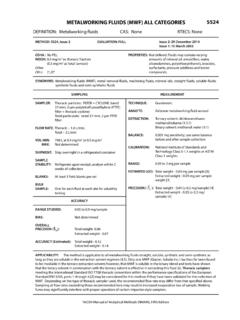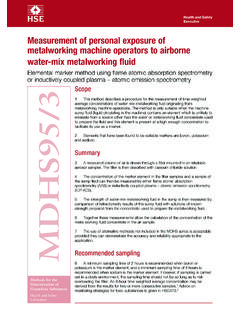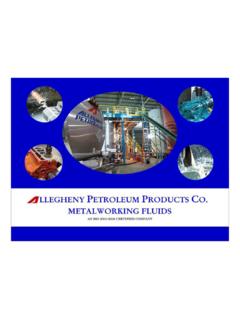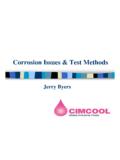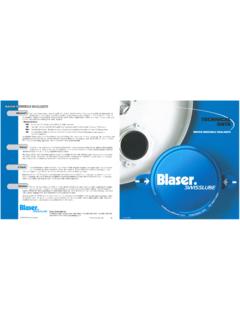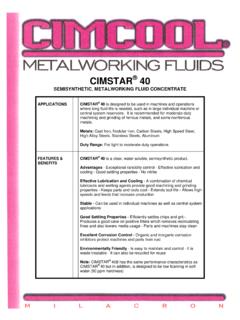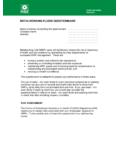Transcription of Metalworking Fluid Mist Occupational Exposure Limits: A ...
1 Journal of Occupational and Environmental Hygiene,3:501 507 ISSN: 1545-9624 print / 1545-9632 onlineCopyrightc 2006 JOEH, LLCDOI: Fluid Mist Occupational Exposure Limits: ADiscussion of Alternative MethodsHoward Cohen1and Eugene M. White21 University of New Haven, New Haven, Connecticut2 Milacron Marketing Company, Cincinnati, OhioNIOSH published a recommended Exposure limit (REL)for Metalworking fluids (MWF) in 1998 that was designed toprevent respiratory disorders associated with these industriallubricants. The REL of mg/m3(as a time-weighted averagefor up to 10 hours) was for the fraction of aerosol correspond-ing to deposition in the thoracic region of the lungs.
2 This non-regulatory Occupational Exposure limit (OEL) corresponded toapproximately mg/m3for total particulate mass. Althoughthis REL was designed to prevent respiratory disorders fromMWF exposures, NIOSH acknowledged that exposures belowthe REL may still result in Occupational asthma and hypersen-sitivity pneumonitis two of the most significant respiratoryillnesses associated with MWF. In the 8 years since the pub-lication of the NIOSH MWF REL, neither the OccupationalSafety and Health Administration (OSHA) nor the AmericanConference of Governmental Industrial Hygienists (ACGIH R)has recommended an Exposure limit for water-soluble MWFspecifically, other than their previous Exposure limits for min-eral oil.
3 An informal effort to benchmark companies involved inthe manufacture of automobiles and automotive parts in NorthAmerica indicated that most companies are using the NIOSHMWF REL as a guide for the purchase of new , most companies have adopted a goal to limitexposures to below to find any companythat has strictly enforced an OEL of mg/m3through the useof either administrative controls or personal protective equip-ment, when engineering controls failed to bring the exposuresto below this limit. We also found that most companies havefailed to implement specific medical surveillance programs forthose employees exposed to MWF mist above Resources Counselors (ORC) published in 1999 (ontheir website) a best practices manual for maintaining MWFsystems and reducing the likelihood of MWF-related emphasis of this approach was on control techniques, andthere was no assignment of a specific OEL for MWF due tothe wide variety of fluids that exist.
4 The ORC did suggest thatmaintaining Exposure levels to below mg/m3would assistin minimizing upper respiratory complaints associated withMWF. Although the ORC manual indicated that MWF vary incomposition and no single OEL is likely to be appropriate forall such fluids, it adopted a very similar concept to controlbanding, placing all MWF operations into a single band usingsimilar (if not identical) controls. OSHA, in lieu of adopting a6B health standard for MWF, has also published a voluntary best practices manual on their website.
5 Their documentdrew heavily from the work of ORC and also incorporatedinformation from the 1998 NIOSH MWF criteria users of MWF need to have guidance, such as anOEL, to determine when either engineering, administrativecontrols, or personal protective equipment must be implementedto protect their employees. The purpose of this article is toexplore various approaches that might be taken to result in asingle or multiple limits for exposures to MWF and its com-ponents. Approaches such as control banding are discussed interms of an alternative to the use of an banding, Exposure assessment, metalworkingfluids, mist generation, Occupational Exposure limits,risk assessmentAddress correspondence to: Howard Cohen, University of NewHaven, 300 Boston Post Rd.
6 , West Haven, CT 06561; for this project was not provided by Milacron or anyfederal agency. The opinions expressed in this article are those of theauthors and do not necessarily reflect those of Milacron or any , mineral and animal oils were used exten-sively as industrial lubricants to reduce friction at tool-workpieceinterfaces. Studies in the early 1900s clearly demonstratedthe utility of using water to cool frictional surfaces and, thus,extend tool life.(1,2)The term coolant is frequently used todayto describe water-soluble Metalworking fluids (MWFs).
7 Thefirst water-soluble cutting Fluid was developed in 1945.(3)Acomprehensive treatment of MWF history is provided in Byerset al.(4) Metalworking fluids are complex chemical mixtures thatcan be grouped into four major (most common), vegetable, ani-mal, marine oils with no water content; petroleum-basedoils may be severely hydrotreated or severely solventrefined to reduce polynuclear aromatic hydrocarbon 85% naphthenic or paraffinic oil con-taining emulsifiers and additivesJournal of Occupational and Environmental HygieneSeptember 20% mineral oil emulsified oil content.
8 A mixture of or-ganics and additives to provide lubricity (reduce friction)and corrosion prevention, 70 95% water , MWF products are provided to end-users as con-centrates that are then diluted with water from 1 20% at thepoint-of-use. In this regard, an average dilution of about 5% iscommonly used for many machining of MWF have modified formulations overthe years in response to health and environmental of these modifications: Removal ofnitrites(rust inhibitors) potential to combinewith secondary amines to form carcinogenic nitrosoamines Removal ofpolychlorinated biphenyls(high-pressurelubricants) toxicity, mutagenicity concerns Reduction in use ofdiethanolamines(corrosion inhibitors) toxicity concerns Reduction ofphenolic compounds(biocides) recalcitrantto wastewater treatment Removal of4-tert-Butylbenzoic acid(corrosion inhibitor) potential allergen Removal ofdichromates(corrosion inhibitors)
9 Potentialallergens, cause skin disorders Severe refining of mineral oils (lubricants) to reducepolynu-clear aromaticcontent potential tumorigens, adverse re-productive effects Replacement ofglycol ethers(couplers) may form explo-sive peroxides Reduction in use ofbarium sulfates(emulsifiers) insolubleand resistant to wastewater chemical additives are formulated into metalwork-ing fluids in order to achieve specific performance require-ments. Categories of common additives and their basic func-tions are shown in Table I. Additive packages, that is, com-binations of chemical additives, may be introduced into MWFformulations to fulfill specific machining requirements, suchTABLE I.
10 Examples of MWF AdditivesAdditive TypeExamplesCorrosioninhibitorsAmine carboxylates, amine borates,tolytriazole saltsEmulsifiersSoaps, sulfonates, alkanolamidesCouplersGlycol ethersExtreme pressure(EP) lubricantsSulfurized, phosphated compoundsEPA-approvedBiocidesTriazines, oxazolidines,isothiazolones, phenolicsLubricantsSulfurized fatty oils, phosphate esters,dibasic acid esterspH bufferingAlkanolaminesDispersantsPrimary amino alcoholsas lubricity specifications, corrosion resistance, biocidal effec-tiveness, high-speed/high-pressure applications, and so MWF contained in both small sumps and large cen-tral systems are prone to microbial contamination by variousspecies of bacteria, fungi, and algae.
